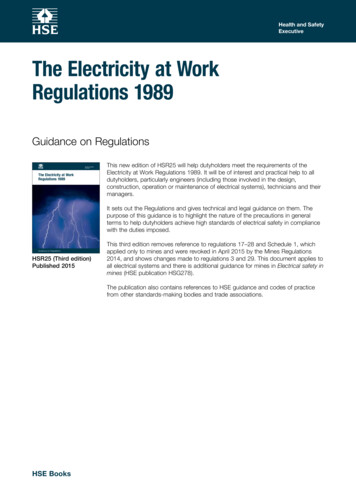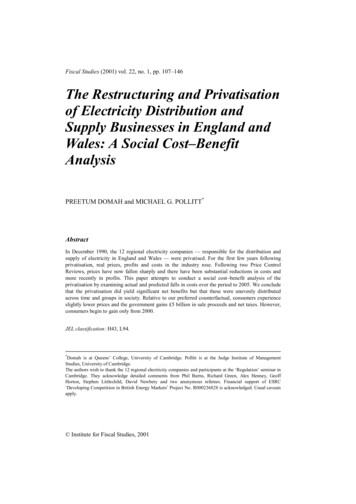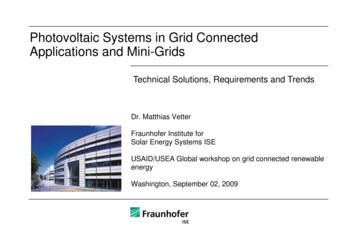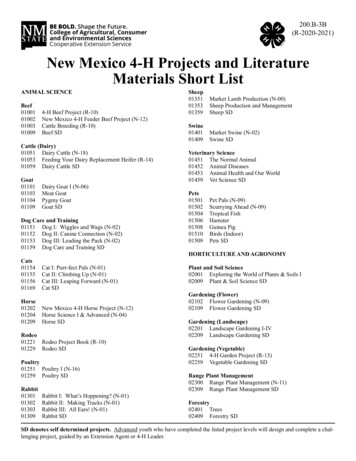
Transcription
Health and SafetyExecutiveThe Electricity at WorkRegulations 1989Subtitle H6Guidance on RegulationsHealth and SafetyExecutiveThe Electricity at WorkRegulations 1989Subtitle H6This new edition of HSR25 will help dutyholders meet the requirements of theElectricity at Work Regulations 1989. It will be of interest and practical help to alldutyholders, particularly engineers (including those involved in the design,construction, operation or maintenance of electrical systems), technicians and theirmanagers.It sets out the Regulations and gives technical and legal guidance on them. Thepurpose of this guidance is to highlight the nature of the precautions in generalterms to help dutyholders achieve high standards of electrical safety in compliancewith the duties imposed.Guidance on RegulationsHSR25 (Third edition)Published 2015This third edition removes reference to regulations 17–28 and Schedule 1, whichapplied only to mines and were revoked in April 2015 by the Mines Regulations2014, and shows changes made to regulations 3 and 29. This document applies toall electrical systems and there is additional guidance for mines in Electrical safety inmines (HSE publication HSG278).The publication also contains references to HSE guidance and codes of practicefrom other standards-making bodies and trade associations.HSE Books
Health and SafetyExecutiveThe Electricity at Work Regulations 1989 Crown copyright 2015First published 1989Second edition 2007Third edition 2015ISBN 978 0 7176 6636 2You may reuse this information (excluding logos) free of charge in any format ormedium, under the terms of the Open Government Licence. To view the licencevisit cence/, write to theInformation Policy Team, The National Archives, Kew, London TW9 4DU, or emailpsi@nationalarchives.gsi.gov.uk.Some images and illustrations may not be owned by the Crown so cannot bereproduced without permission of the copyright owner. Enquiries should be sent tocopyright@hse.gsi.gov.uk.GuidanceThis guidance is issued by the Health and Safety Executive. Following the guidanceis not compulsory, unless specifically stated, and you are free to take other action.But if you do follow the guidance you will normally be doing enough to comply withthe law. Health and safety inspectors seek to secure compliance with the law andmay refer to this guidance.Page 2 of 52
Health and SafetyExecutiveThe Electricity at Work Regulations 1989ContentsIntroduction5The Regulations7Regulation 1Citation and commencementRegulation 2InterpretationRegulation 3Persons on whom duties are imposed by theseRegulations13Regulation 4Systems, work activities and protective equipmentRegulation 5Strength and capability of electrical equipmentRegulation 6Adverse or hazardous environmentsRegulation 7Insulation, protection and placing of conductorsRegulation 8Earthing or other suitable precautionsRegulation 9Integrity of referenced conductorsRegulation 10ConnectionsRegulation 11Means for protecting from excess of currentRegulation 12Means for cutting off the supply and for isolationRegulation 13Precautions for work on equipment made deadRegulation 14Work on or near live conductorsRegulation 15Working space, access and lightingRegulation 16Persons to be competent to prevent danger and injuryRegulations 17–2871819222529DefenceRegulation 30Exemption certificatesRegulation 31Extension outside Great BritainRegulation 32Disapplication of dutiesRegulation 33Revocations and modificationsAppendix 14643444852Page 3 of 523133353743References and further reading1530Regulation 29Further information74445454142
Health and SafetyExecutiveThe Electricity at Work Regulations 1989Page 4 of 52
Health and SafetyExecutiveThe Electricity at Work Regulations 1989IntroductionAbout this book1This book gives guidance on and sets out the Electricity at Work Regulations1989. The guidance is relevant to all work activities and premises except certainoffshore workplaces and certain ships. Additional guidance specific to mines isgiven in Electrical safety in mines.12The Electricity at Work Regulations 1989 (SI 1989/635) (as amended) (theRegulations) came into force on 1 April 1990. The purpose of the Regulations is torequire precautions to be taken against the risk of death or personal injury fromelectricity in work activities. The text of the Regulations is available free to downloadfrom legislation.gov.uk or to purchase from The Stationery Office.3The Regulations are made under the Health and Safety at Work etc Act 1974(the HSW Act).2 The HSW Act applies principally to employers, the self-employedand to employees, including certain classes of trainees. Duties are imposed onpeople (referred to in this guidance as ‘dutyholders’) in respect of systems,electrical equipment and conductors, and in respect of work activities on or nearelectrical equipment. Words in bold (above and in extracts from the Regulations)are defined in regulation 2. The duties are in addition to those imposed by the HSWAct. The 1989 Regulations pre-date the risk assessment process brought in withthe 1992 version of the Management of Health and Safety at Work Regulations.However, the risk assessment process is still required. Further information can befound in Managing for health and safety.3What are the differences between this edition and the previousedition?4This third edition notes that regulations 17–28 and Schedule 1, which appliedonly to mines, were revoked in April 2015 by the Mines Regulations 2014. TheseRegulations also modified regulations 3 and 29.Who should read this book?5The guidance is primarily for dutyholders (including those involved in thedesign, construction, operation or maintenance of electrical systems andequipment), engineers, technicians and their managers. It sets out the Regulationsand gives technical and legal guidance on them. While it reflects the Health andSafety Executive’s (HSE’s) view of the meaning of terms used in the Regulations,only the Courts can provide a binding interpretation. The text of the Regulations isset out in italics, the accompanying guidance is in normal type. Coloured bordersalso indicate each section clearly.Page 5 of 52
Health and SafetyExecutiveThe Electricity at Work Regulations 1989Scope6This guidance applies to all operational voltages.7The Regulations apply to all electrical systems and equipment (as defined)whenever manufactured, purchased, installed or taken into use even if itsmanufacture or installation pre-dates the Regulations. Where electrical equipmentpre-dates the Regulations this does not of itself mean that the continued use of theequipment would be in contravention of the Regulations. For example, some of theequipment to which the Regulations apply may have been made to a standard,such as a British Standard, which has since been modified or superseded.Standards such as BS 76714 can provide assistance but, ultimately, compliancewith the Regulations is required. It is likely to be reasonably practicable to replace itwith equipment made to a more recent standard when, but only when, it becomesunsafe or falls due for replacement for other than safety reasons, whichever occurssooner.British Standard BS 7671 Requirements for ElectricalInstallations (also known as the IET Wiring Regulations)8BS 7671 Requirements for electrical installations is also known as the IETWiring Regulations. They are non-statutory regulations which ‘relate principally tothe design, selection, erection, inspection and testing of electrical installations,whether permanent or temporary, in and about buildings generally and toagricultural and horticultural premises, construction sites and caravans and theirsites’.9BS 7671 is a code of practice which is widely recognised and accepted in theUK and compliance with it is likely to achieve compliance with relevant aspects ofthe Electricity at Work Regulations 1989.10 There are, however, many types of system, equipment and hazard to whichBS 7671 is not applicable; for example, certain installations at mines and quarries,equipment on vehicles, systems for public electricity supply and explosionprotection. Furthermore, BS 7671 applies only to installations operating at up to1000 V ac or 1500 V dc.11 Installations to which BS 7671 is relevant may have been installed inaccordance with an earlier edition, now superseded but then current. That, in itself,would not mean that the installation would fail to comply with the Regulations.Electricity Safety, Quality and Continuity Regulations12 The Electricity Safety, Quality and Continuity Regulations 2002 (ESQCR)5impose requirements in respect of the generation, distribution and supply ofelectricity, including supply networks and electrical equipment. The Department ofEnergy and Climate Change (DECC) leads on ESQCR matters, though HSEperforms some functions on DECC’s behalf, in particular with regards to publicsafety and incident notifications. Some ESQCR obligations – such as requirementsfor connection with earth – overlap with the Regulations, but others provideadditional requirements.Page 6 of 52
Health and SafetyExecutiveThe Electricity at Work Regulations 1989The RegulationsRegulation 1 Citation and commencementRegulation1These Regulations may be cited as the Electricity at Work Regulations 1989 andshall come into force on 1st April 1990.Regulation 2 InterpretationRegulation2(1)In these Regulations, unless the context otherwise requires –“circuit conductor” means any conductor in a system which is intended to carryelectric current in normal conditions, or to be energised in normal conditions, andincludes a combined neutral and earth conductor, but does not include aconductor provided solely to perform a protective function by connection to earthor other reference point;“conductor” means a conductor of electrical energy;“danger” means risk of injury;“electrical equipment” includes anything used, intended to be used or installed foruse, to generate, provide, transmit, transform, rectify, convert, conduct, distribute,control, store, measure or use electrical energy;“injury” means death or personal injury from electric shock, electric burn, electricalexplosion or arcing, or from fire or explosion initiated by electrical energy, where anysuch death or injury is associated with the generation, provision, transmission,transformation, rectification, conversion, conduction, distribution, control, storage,measurement or use of electrical energy;“system” means an electrical system in which all the electrical equipment is, or maybe, electrically connected to a common source of electrical energy, and includessuch source and such equipment.Guidance213 Words and phrases which are in bold type in the text of the regulationpreceding the guidance are those which have been assigned a special meaning bybeing defined in regulation 2.Systems14 The term ‘system’ includes all parts of a system, eg conductors and electricalequipment in it, and is not a reference solely to the functional circuit as a whole. Itfollows that something required of a system is required both of the system as awhole and of the equipment and conductors in it.Page 7 of 52
Health and SafetyExecutiveGuidanceThe Electricity at Work Regulations 1989215 The definition refers to electrical systems. In the case of each system this willinclude all of the electrical equipment connected together and the various electricalenergy sources in that system. In the case of transformers, even though there maybe galvanic separation between the various windings of the transformers, where theenergy is transmitted through these from one part of the electrical system toanother, the transformer and all of its windings are part of the same system.16 The definition of ‘system’ includes equipment which, although not energised,may be electrically connected to a common source of electrical energy. Equipmentwhich is readily capable of being made live by a system is therefore considered tobe part of that system. For example, a lighting circuit which has been disconnectedfrom its source of electrical energy by means of removable links or fuses is still partof that system, as is such a circuit which has been switched off even though theswitch might be a double pole switch.17 Equipment which is in any way connected to a source of electrical energy, ega test instrument containing a source and the equipment containing or connectedto that source, becomes part of a system and the Regulations apply to that system.Electrical equipment which is not connected, and cannot be readily connected, to asource of electrical energy is not part of a system. Protective conductors, if they areconnected to a source, are part of that system.18 The reference in the definition to a common source of electrical energy doesnot exclude systems fed by several generators or transformers. The word‘common’ is included in the definition so that completely independent electricalinstallations are regarded as separate systems. If, however, they are electricallyconnected in any way they are part of the same system for the purposes of theRegulations. This may mean that the system may be an extensive electrical networkcovering large geographical areas over which several or even many people havecontrol of various parts. The Regulations place duties on these people only inrespect of those provisions of the Regulations which relate to matters which arewithin their control (see regulation 3).19 Self-contained portable systems, such as portable generating sets, areelectrical systems for the purpose of the Regulations, as are transportable systemsand systems on vehicles etc.Electrical equipment20 ‘Electrical equipment’ as defined in the Regulations includes every type ofelectrical equipment from, for example, a high-voltage transmission overhead line toa battery-powered hand lamp. There are no voltage limits in the Regulations; thecriteria are whether danger (as defined) may arise. It is appropriate for theRegulations to apply even at the very lowest end of the voltage or power spectrumbecause the Regulations are concerned with, for example, explosion risks, whichmay be caused by very low levels of energy igniting flammable gases even thoughthere may be no risk of electric shock or burn.21 Electrical equipment (as defined) includes conductors used to distributeelectrical energy such as cables, wires and leads and those used in thetransmission at high voltage of bulk electrical energy, as in the national grid.Conductors22 Regulation 2 defines a conductor as ‘a conductor of electrical energy’. Thismeans any material which is capable of conducting electricity (electricity issynonymous with electrical energy) and therefore includes both metals and all otherPage 8 of 52
Health and SafetyExecutiveGuidanceThe Electricity at Work Regulations 19892conducting materials. The definition is not limited to conductors intended to carrycurrent and so includes, for example, metal structures, salt water, ionised gasesand conducting particles. The conductance of most materials varies withparameters such as temperature, eg glass is conducting when molten (and is thena conductor, as defined) whereas in its normal, solid, state it is a good insulatorand finds many applications as such. For the purposes of the Regulations, whilesuch materials conduct electricity, they are ‘conductors’.Figure 1 Types of conductorL1These conductorsenclosed by thisdotted line arecircuit conductors(by definition)L2L3NEWithin these dottedlinesthe conductors areconductors in a systemsince they are electricallyconnected to a commonsource of electrical energy3 Phase system – separate neutral and earthThese are conductors in a systemBut not circuit conductorsLNProtectiveconductorThe combined neutral/earth conductor serves as both a neutral anda protective conductorand is therefore a circuit conductor as well asa conductor in a systemSystem including both combined and separateneutral and earth conductors (single phase only shown)Page 9 of 52
Health and SafetyExecutiveGuidanceThe Electricity at Work Regulations 19892Circuit conductor23 This definition is used in regulations 8 and 9 only. It distinguishes from allother conductors those conductors whose normal function is to carry load currentor to be energised (see Figure 1).Danger24 The Regulations use the two defined terms, ‘danger’ and ‘injury’. ‘Danger’ isdefined as ‘risk of injury’. ‘Injury’ is defined in terms of certain classes of potentialharm to people.25 Where the term ‘prevent danger’ is used it should therefore be read as‘prevent the risk of injury’.26 The Regulations make requirements to ‘prevent danger’ or ‘prevent injury’ – orin the case of regulation 16 – ‘to prevent danger or, where appropriate, injury’. Thepurpose of the distinction between ‘injury’ and ‘danger’ is to accommodate thosecircumstances when people must work on or so near live equipment that there is arisk of ‘injury’, ie where ‘danger’ is present and cannot be prevented. In thesecircumstances, under regulation 14, danger may be present but injury must beprevented.27 The type of injuries with which the Regulations are concerned are detailed inthe definition of ‘injury’ in the regulation (see paragraphs 29 and 30). The scope ofthe Regulations does not include consequential dangers such as crushing injuriescaused by a machine going out of control following an electrical malfunction. Suchother dangers are subject to other legal requirements under, for example, the HSWAct, the Factories Act 1961 and the Office, Shops and Railway Premises Act 1963.28 If no danger arises from a particular system, item of electrical equipment orconductor and will not arise, then the Regulations, although applying to it, do notrequire any precautions to be taken. However, in order for there to be no danger,there would have to be no risk of electric shock, electric burn, fire, arcing or explosion.Injury29 The purpose of the Regulations is to prevent death or personal injury to anyperson from electrical causes in connection with work activities.30(a)(b)(c)(d)(e)‘Injury’ means death or injury to any person from:electric shock;electric burn;fires of electrical origin;electric arcing;explosions initiated or caused by electricity.Electric shock31 The human body responds in several ways to electrical current flowingthrough it. The sensation of shock is only one such effect and this can be extremelypainful. When a shock is received, the electric current may take multiple pathsthrough the body and its intensity at any one point is difficult or impossible topredict. The passage of electric current may cause muscular contractions,respiratory failure, fibrillation of the heart, cardiac arrest or injury from internal burns.Any of these can be fatal.Page 10 of 52
Health and SafetyExecutiveGuidanceThe Electricity at Work Regulations 1989232 The nature and severity of injury depends upon the magnitude, duration andpath of the current through the body and, in the case of alternating current (ac), onits frequency. It is not possible to identify precise thresholds for the existence ofhazard because a judgement has to be made in each case taking all thecircumstances into account, such as body weight, physical condition of the victimand so forth. Nevertheless, a guide to the sort of current magnitudes which markthe occurrence of various dangerous effects is given in the InternationalElectrotechnical Commission’s (IEC’s) publication Guide to effects of current onhuman beings and livestock. Special aspects relating to human beings.6 Quite lowcurrents, of the order of only a few milliamps (mA), can cause fatal electric shock.33The likely effects of shock current are mainly influenced by:(a)(b)(c)(d)voltage;frequency;duration;any impedance in the current path.34 The effects of electric shock are most acute at around the public electricitysupply frequency of 50 hertz. Susceptibility to electric shock is increased if aperson is in:(a)(b)good electrical contact with earth, such as in damp or wet conditions or inconducting locations such as inside a metal tank;hot environments where people may become damp due to perspiration orhumidity, thus reducing the insulation protection offered by clothing.35 The variability of conditions makes it impossible to specify a voltage which isguaranteed to be safe in all situations. In any situation, you should consider the riskof injury from electric shock against published guidance as to the voltages andother factors which have been found by extensive experience to be safe. Thisincludes national and international standards and technical publications. However,these documents should be interpreted carefully and with a view to the limitationsof their various scopes and assumptions. You should always consider theconventional public electricity supply voltage of 230 V ac as potentially fatallydangerous. Many fatal electric shock accidents have occurred from contact withconductors live at this voltage and possibly the most dangerous situation is wherecontact is made with conductors by each hand, current then flowing ‘hand tohand’ across the heart region.36The following documents give some guidance (see References):(a)(b)(c)Guide to effects of current on human beings and livestock (IEC TS 60479);Requirements for electrical installations (BS 7671);Safety of equipment electrically connected to a telecommunications network(IEC 62151).7Electric burn37 Electric burns are different from burns due to fire (see paragraphs 39–40),arcing (see paragraphs 41–42) or explosion (see paragraphs 44–46). They are dueto the heating effect caused by the passage of electric current through bodytissues. They are most commonly associated with electric shock and often occur inand on the skin layers at the point of contact with the electrical conductors whichgave rise to the electric shock. Electrical arcs jump across gaps and can causeburns.Page 11 of 52
Health and SafetyExecutiveGuidanceThe Electricity at Work Regulations 1989238 At high frequencies, eg radio frequencies (RF), which include microwaves, itmay not even be necessary for contact to be made with live conductors for anelectric burn to be received. In the case of RF, the heating is by absorption of theelectromagnetic wave energy by a dielectric loss process in the body of the victim.RF burns can thus be extremely deep within the body. RF burning can occurwithout the sensation of shock, particularly if no contact is made with the RFconductors, and can therefore cause severe injury before the victim is aware oftheir occurrence. Electric burns are usually painful and very slow to heal.Permanent scarring is common.Fires of an electrical origin39 Fires may be started by electricity in a number of ways. The main causes are:(a)(b)(c)(d)overheating of cables and electrical equipment due to overloading ofconductors;leakage currents due to poor or inadequate insulation;overheating of flammable materials placed too close to electrical equipmentwhich is otherwise operating normally;the ignition of flammable materials by arcing or sparking of electricalequipment, including the scattering of hot particles from electrical equipment.40 The injuries associated with fire are usually burns but may include otherinjuries such as smoke inhalation, each with the potential to kill.Arcing41 Arcing causes a particular type of burn injury which is distinct from othertypes. Arcing generates ultraviolet radiation which causes damage similar to severesunburn. Molten metal particles from the arc itself can penetrate burn and lodge inthe flesh. These effects are additional to any radiated heat damage caused by the arc.42 On its own, ultraviolet radiation can cause damage; sensitive skin and eyesare especially vulnerable to arc flash. (‘Arc eye’ is commonly encountered withelectric arc welding if the proper precautions are not adopted.)43 Arcing faults can occur if the energy available at a piece of electricalequipment is sufficient to maintain a conductive path through the air or insulationbetween two conductors which are at different potentials. Under fault flashoverconditions, currents many times the nominal rating or setting of a protective devicemay flow before those devices operate to clear the fault. Much energy is dissipatedin the arc and, depending on the electrical protection, may continue long enough toinflict very serious arcing burns or to initiate a fire. These periods can be as short as0.2 seconds. Arc flashovers caused during work on live circuit conductors are likelyto be particularly hazardous because the worker is likely to be very near to or evenenveloped by the arc. Such cases often lead to very serious, sometimes fatal, burninjuries.Explosion44 This category includes those injuries caused by explosions either of anelectrical nature or those ignited by an electrical source.45 Electrical explosions include the violent and catastrophic rupture of anyelectrical equipment. Switchgear, motors and power cables are liable to explode ifthey are subjected to excessive currents, which release violent electromagneticforces and dissipate heat energy, or if they suffer prolonged internal arcing faults.46 Explosions caused by ignition from an electrical source include ignition offlammable vapours, gases, liquids and dusts by electrostatic discharge, electricsparks, arcs or the high surface temperature of electrical equipment.Page 12 of 52
Health and SafetyExecutiveGuidanceThe Electricity at Work Regulations 19892Other words used in the RegulationsCharged/live (as used in regulations 8, 13 and 14)47 The terms ‘charged’ and ‘live’ have different meanings; they are not defined inthe Regulations so they take their ordinary meaning. ‘Live’ means equipment that isat a voltage by being connected to a source of electricity. ‘Charged’ means that theitem has acquired a charge either because it is live or because it has becomecharged by other means, such as static or induction charging, or has retained orregained a charge due to capacitance effects even though it may be disconnectedfrom the rest of the system.Dead (as used in regulations 13 and 14)48 The term ‘dead’ is not defined in the Regulations so it takes its ordinarymeaning. Thus, in the context of the Regulations, for a conductor to be ‘dead’means that it is neither ‘live’ nor ‘charged’.Other words used in the guidanceHigh voltage, low voltage49 High voltage is a voltage in excess of 1000 V ac or 1500 V dc (directcurrent). Low voltage is a voltage up to and including 1000 V ac or 1500 V dc.Live work50 Live work is work on or near conductors that are accessible and ‘live’ or ‘charged’.Note that testing of live exposed conductors using a test instrument is live work.Regulation 3 Persons on whom duties are imposed bythese RegulationsRegulation3(1) Except where otherwise expressly provided in these Regulations, it shallbe the duty of every –(a)(b)employer and self-employed person to comply with the provisions ofthese Regulations in so far as they relate to matters which are within hiscontrol; and[(i) mine operator, in relation to a mine within the meaning of regulation 3of the Mines Regulations 2014, and]*(ii) operator, in relation to a quarry within the meaning of regulation 3of the Quarries Regulations 1999,to ensure that all requirements or prohibitions imposed by or under theseRegulations are complied with in so far as they relate to the mine ofwhich he is the [mine operator]* or quarry of which he is the operator andto matters which are within his control.(2)It shall be the duty of every employee while at work –(a)to co-operate with his employer so far as is necessary to enable any dutyplaced on that employer by the provisions of these Regulations to becomplied with; andto comply with the provisions of these Regulations in so far as they relateto matters which are within his control.(b)[(3) In this regulation, “mine operator” has the meaning given by regulation2(1) of the Mines Regulations 2014.]** Amended by the Mines Regulations 2014, SI 2014/3248.Page 13 of 52
Health and SafetyExecutiveGuidanceThe Electricity at Work Regulations 19893Employer51For the purposes of the Regulations, an employer is any person or body who:(a)employs one or more individuals under a contract of employment orapprenticeship; orprovides training under the schemes to which the HSW Act applies throughthe Health and Safety (Training for Employment) Regulations 1990(SI 1990/1380).(b)Self-employed52 A self-employed person is an individual who works for gain or reward otherthan under a contract of employment, whether or not they employ others. Theyencounter the same risks as employed people.Employee53 Regulation 3(2)(a) reiterates the duty placed on employees by section 7(b) ofthe HSW Act.54 Regulation 3(2)(b) places duties on employees equivalent to those placed onemployers and self-employed people where these are matters within their control.This will include those trainees who will be considered as employees under theRegulations described in paragraph 51.55 This arrangement recognises the level of responsibility which many employeesin the electrical trades and professions are expected to take on as part of their job.The ‘control’ which they exercise over the electrical safety in any particularcircumstances will determine to what extent they hold responsibilities under theRegulations to ensure that the Regulations are complied with.56 A person may find themselves responsible for causing danger to ariseelsewhere in an electrical system, at a point beyond their own installation. Thissituation may arise, for example, due to unauthorised or unscheduled back feedingfrom their installation onto the system, or to raising the fault power level on thesystem above rated and agreed maximum levels due to connecting extrageneration capacity etc. Because such circumstances are within their control, theeffect of regulation 3 is to bring responsibilities for compliance with the rest of theRegul
The publication also contains references to HSE guidance and codes of practice . from other standards-making bodies and trade associations. Guidance on Regulations. Guidance on Regulations. The Electricity at Work Regulations 1989. Subtitle H6. Health and Safety Executive. HSR25 (Third edition) Published 2015. Health and Safety . Executive. The Electricity at Work . Regulations 1989. Subtitle .










